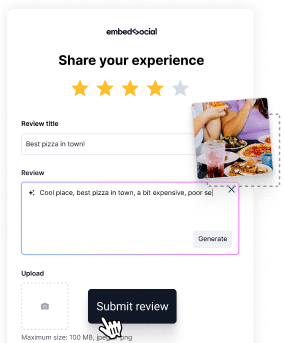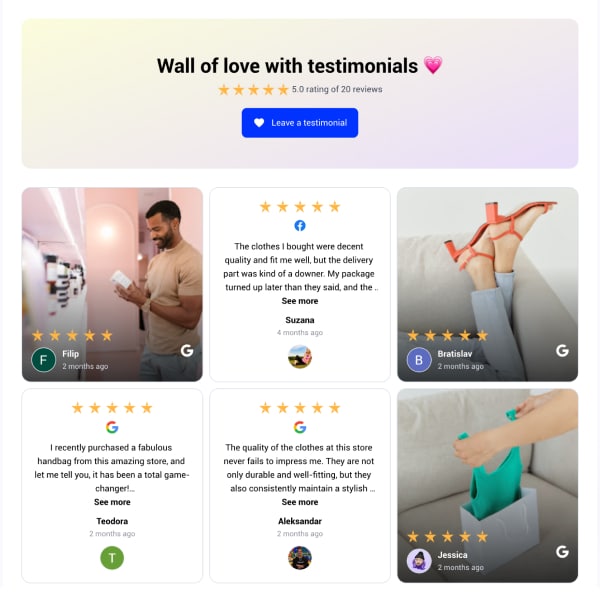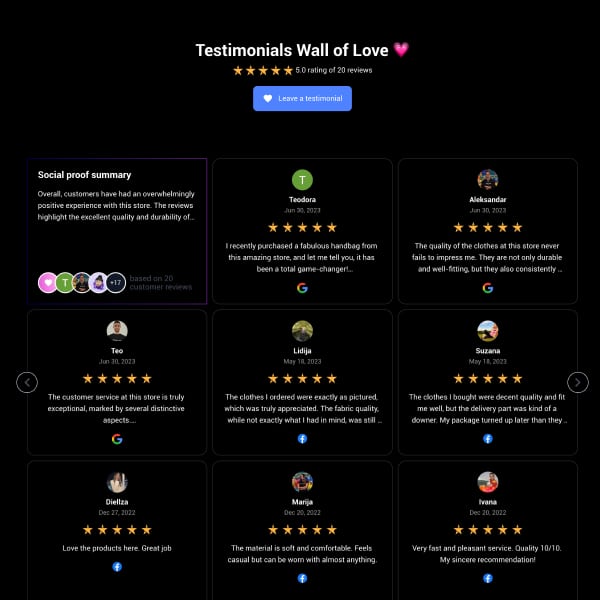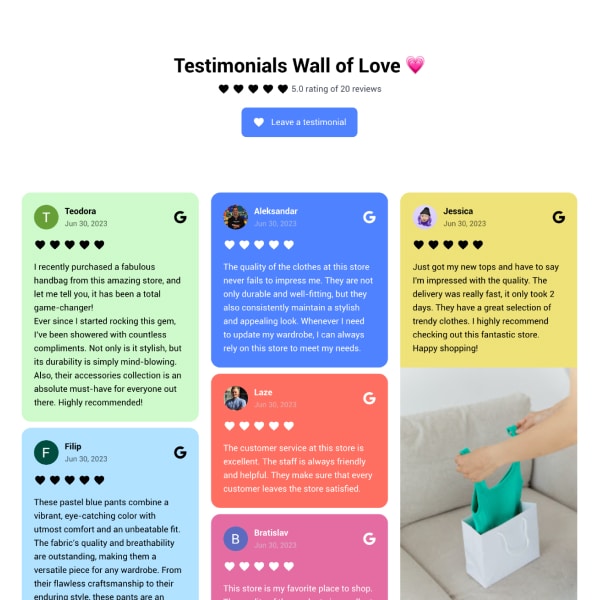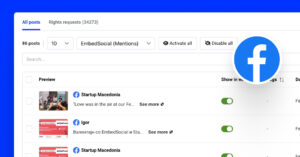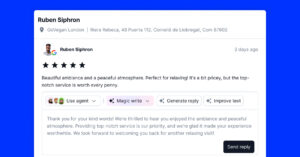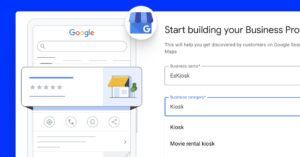La satisfaction des clients est l'un des facteurs les plus importants de la croissance d'une entreprise, car elle offre de nombreux avantages, allant de l'amélioration de la confiance et de l'exposition à la marque à l'augmentation du trafic organique et à l'apport d'un retour d'information sur vos services - ce qui, en fin de compte, se traduit par une augmentation des ventes.
Le meilleur moyen d'exprimer cette satisfaction est la page de témoignages de clients, car il s'agit essentiellement d'un éloge gratuit de vos offres et d'un puissant outil de marketing et de vente.
Si vous avez toujours voulu en savoir plus sur la collecte, l'affichage et l'analyse des avis et des témoignages en ligne et hors ligne, lisez ce qui suit !
Comment recueillir des témoignages gratuitement ?
Pour commencer à collecter des commentaires avec la plateforme EmbedReviews, vous devez tout d'abord créer un compte gratuitVous devez ensuite vous connecter et suivre les étapes suivantes :
- Naviguez jusqu'à Collecter le formulaire dans le menu principal ;
- Personnalisez le formulaire en fonction de vos besoins. Sélectionnez les champs obligatoires ;
- Les utilisateurs payants peuvent activer un assistant d'évaluation IA pour recueillir davantage de témoignages textuels.
- Une fois la personnalisation terminée, allez dans Code et copiez l'URL du formulaire.
Voir les étapes ci-dessous :
Vous pouvez utiliser l'URL de ce formulaire et l'envoyer à vos clients par courrier électronique afin qu'ils puissent directement soumettre leurs avis et témoignages.
Vous pouvez également choisir d'inclure ce formulaire dans tous vos widgets et d'ajouter un bouton "laisser un avis" qui renvoie à la page d'accueil du site. Formulaire de collecte d'examens personnalisés.
Tous les témoignages et les avis que vous recevrez seront enregistrés dans la base de données. Sources > Formulaire de collecte source.
Ensuite, vous pouvez créer un widget avec ceci Collecter le formulaire et afficher les avis recueillis sur votre site web :
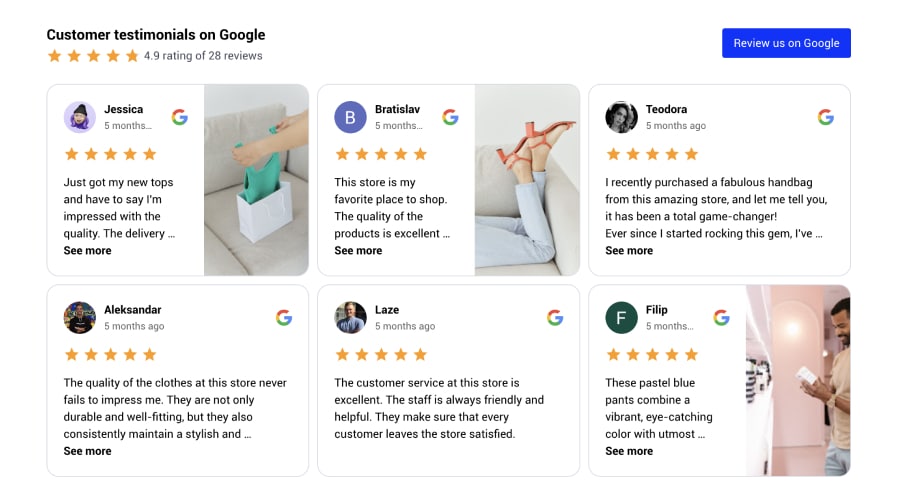
Pour des informations plus détaillées, consultez notre article de blog ci-dessous qui présente plusieurs méthodes principales de collecte de témoignages, comme indiqué ci-dessous.
Article de blog connexe
Qu'est-ce qu'un témoignage de client ?
Les témoignages sont généralement des déclarations écrites ou orales qui louent et recommandent la qualité d'un produit ou d'un service, souvent sur la base d'une expérience ou d'une satisfaction personnelle.
En tant que tels, ils constituent le meilleur type de preuve sociale qui soit, et sont donc utilisés avec succès comme caution dans la publicité, les pages de vente et le matériel de marketing.
Témoignages et évaluations
Avant d'aller plus loin, notons les différences entre les témoignages et les évaluations :
Origine
- Témoignages: Généralement sollicité ou sélectionné par l'entreprise ou la personne faisant l'objet de l'éloge.
- Commentaires: Ils peuvent être non sollicités et sont générés par des clients ou des utilisateurs, souvent sur des plateformes tierces.
Contenu
- Témoignages: Généralement positive, elle souligne les points forts ou les avantages d'un produit, d'un service ou d'une personne.
- Commentaires: Peut être positif ou négatif, offrant une vue plus complète de l'expérience d'un utilisateur.
Objectif
- Témoignages: Principalement utilisé à des fins promotionnelles pour renforcer la confiance et la crédibilité des entreprises.
- Commentaires: Fournir aux clients potentiels des informations impartiales sur les produits de consommation.
Contrôle et présentation
- Témoignages: Généralement contrôlés par l'entreprise, ils lui permettent de choisir les témoignages à publier et l'endroit où les faire figurer, mettant ainsi généralement en évidence les aspects positifs du produit ou du service.
- Commentaires: Souvent présents sur les plateformes indépendantes, ils offrent un large éventail d'avis de clients, y compris des éloges et des critiques, ce qui permet d'avoir une vue d'ensemble de l'expérience des utilisateurs.
Remarque : Bien qu'il y ait une distinction entre les deux termes, les professionnels du marketing utilisent encore l'expression témoignages et les commentaires élogieux sont presque interchangeables car ils ont généralement le même objectif : mettre en valeur les points forts de la marque tels qu'ils sont présentés par des tiers non affiliés.
Quels sont les types de témoignages ?
Comprendre les différents types de témoignages textuels et vidéo utilisés peut aider les entreprises à élaborer des stratégies de marketing plus efficaces :
Témoignages de citations
Il s'agit de déclarations brèves et directes, généralement écrites ou en anglais. témoignages vidéoIl s'agit de l'éloge d'un produit ou d'un service par des clients, souvent sur des sites web ou des supports de marketing.
Témoignages vidéo
Il s'agit de témoignages capturés sur vidéo, qui décrivent souvent des clients partageant leurs expériences positives avec un produit ou un service de manière plus personnelle et plus engageante. Vous devriez toujours recueillir des témoignages vidéo et les intégrer à votre site web grâce à l'un des nombreux logiciels de témoignages.
Témoignages d'influenceurs
Il s'agit d'influenceurs des médias sociaux ou de blogueurs qui font la promotion d'un produit ou d'un service auprès de leur public, en tirant parti des canaux des médias sociaux, de leur portée et de leur influence pour se porter garants de la qualité ou de l'efficacité du produit.
Témoignages sociaux
Il s'agit de commentaires positifs ou d'approbations partagés par les utilisateurs sur les plateformes de médias sociaux. Ils peuvent être non sollicités et se présentent souvent sous la forme de commentaires positifs, de partages ou d'appréciations, montrant l'approbation ou la satisfaction de personnes réelles à l'égard d'un produit ou d'un service.
Témoignages d'interview
Il s'agit de témoignages détaillés provenant d'entretiens avec des clients satisfaits, qui discutent en profondeur de leur expérience, offrant ainsi aux clients potentiels un aperçu détaillé des avantages du produit ou du service.
Étude de cas Témoignages
Ces analyses approfondies expliquent en détail comment un produit ou un service a aidé un client ou une entreprise à résoudre un problème ou à atteindre un objectif, en s'appuyant généralement sur des données et des résultats.
Témoignages de pairs
Ces témoignages proviennent de personnes qui partagent des caractéristiques ou des données démographiques similaires à celles du client potentiel, ce qui crée un contexte relationnel et indique que des personnes "comme elles" ont eu des expériences positives avec le produit ou le service.
En rapport :
Comment recueillir des témoignages ? 7 Bonnes pratiques
Il existe plusieurs méthodes pour recueillir davantage de témoignages de clients. Découvrez-les ci-dessous !
1. Utiliser une plateforme de collecte de commentaires
La meilleure façon d'obtenir l'avis des clients est d'utiliser une plateforme de gestion des témoignages telle que EmberReviews puisqu'il peut accéder à des données provenant de tous les Sites d'évaluation sociale populaires.
Par exemple, avec EmbedReveiws, vous pouvez connecter votre profil Google My Business et collecter vos avis Google ou votre page Facebook pour obtenir vos témoignages Facebook.
EmbedReviews se connecte également à des sites d'évaluation tiers tels que Trustpilot, Yelp, Airbnb et autres, ce qui vous permet d'importer et/ou de créer des sources d'évaluation personnalisées.
2. Intégrer un widget de formulaire de retour d'information
Comme indiqué précédemment, vous pouvez utiliser un générateur de formulaires pour concevoir le formulaire de retour d'information adapté à votre entreprise et l'intégrer sous forme de widget sur votre site web. EmbedForms vous permet de créer et d'intégrer des formulaires web attrayants sous forme de widgets sur n'importe quel site. Les clients les apprécient pour leur rapidité, leur efficacité et leur simplicité.
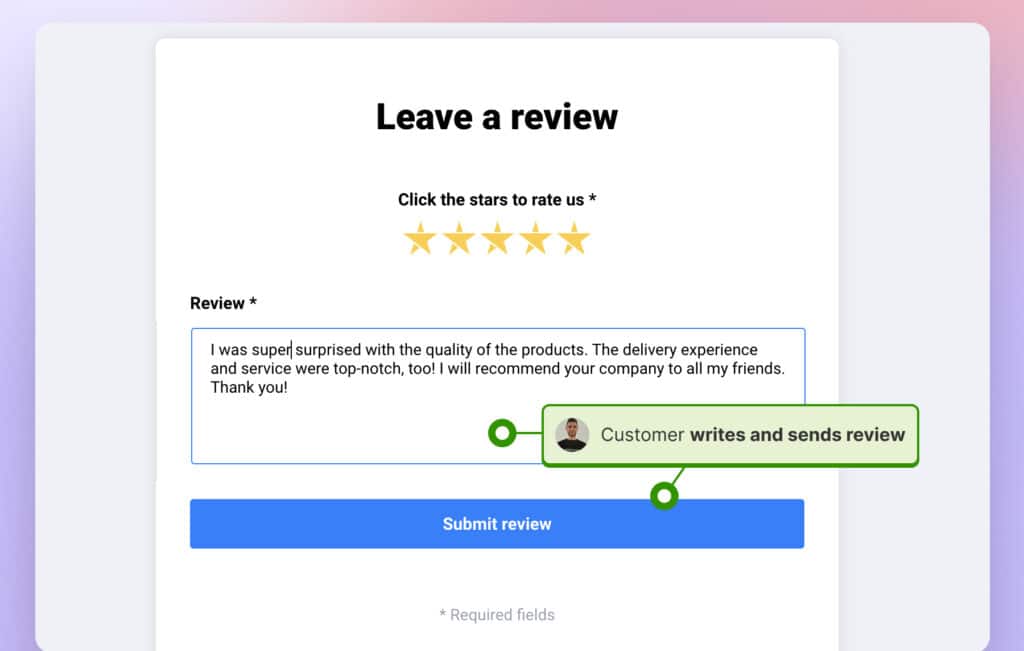
3. Demander des témoignages par courrier électronique
EmbedReviews permet également aux utilisateurs de envoyer des courriels de demande de formulaire de témoignage à un ou plusieurs clients contenant un lien vers un formulaire de demande de témoignage pouvant être rempli à tout moment. Des rappels, des notifications par courrier électronique et des photos incitatives sont quelques-unes des fonctionnalités incluses.

4. Recueillir des témoignages par SMS
Les entreprises disposant des numéros de téléphone de leurs clients peuvent les importer dans EmbedReviews et demander des témoignages par SMS. Cette méthode peut s'avérer très efficace, car les clients sont redirigés vers un formulaire de témoignage adapté aux téléphones portables, où ils n'ont plus qu'à ajouter une note sous forme d'étoiles et à laisser leur avis.
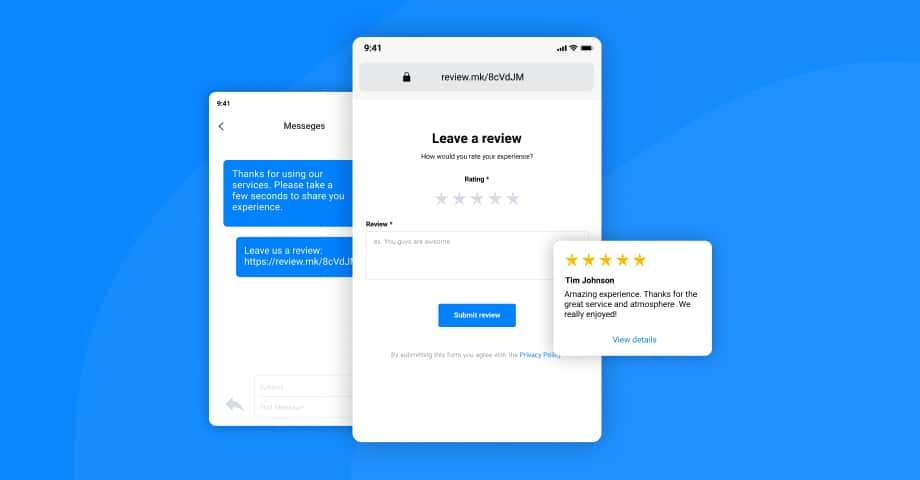
5. Obtenir des témoignages sur les plateformes de commerce électronique
Si vous utilisez une plateforme de commerce électronique comme Shopify, vous pouvez recueillir des avis en configurant un courrier électronique automatisé qui sera envoyé chaque fois qu'un nouveau client achète un produit.
À cette fin, vous pouvez utiliser L'application Verified Reviews d'EmbedSocialqui, une fois installé, recueille et synchronise automatiquement les avis avant de les afficher sur la page du produit concerné.
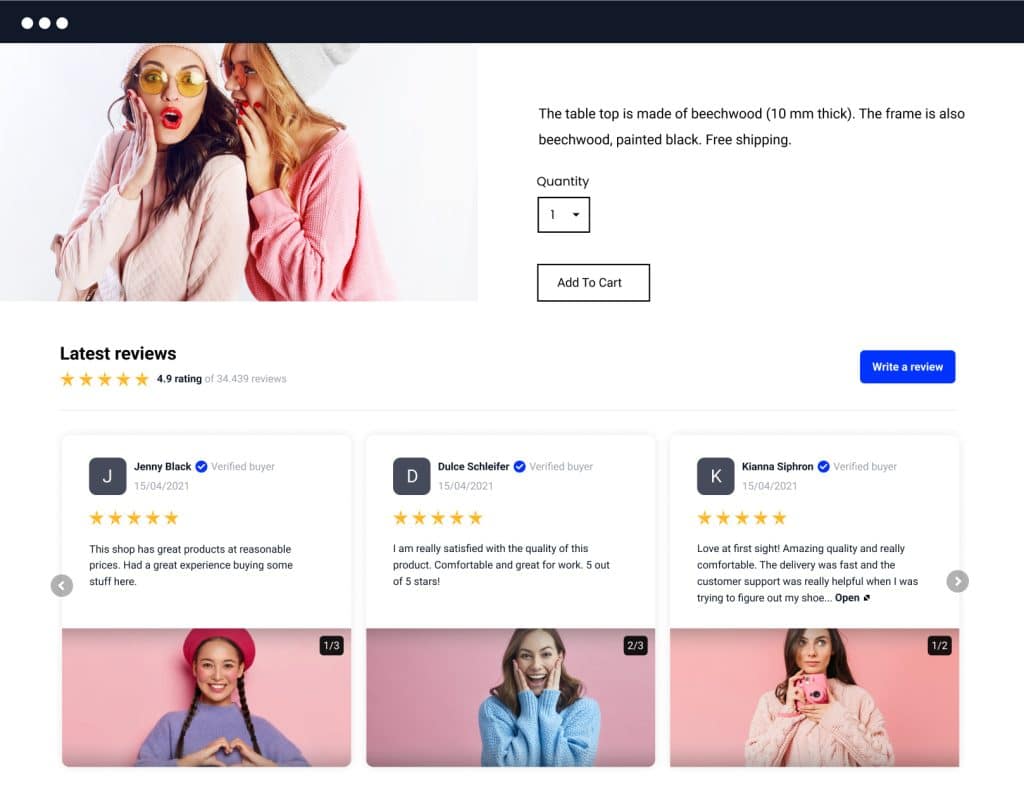
6. Obtenir et télécharger manuellement vos avis
Bien sûr, vous pouvez obtenir des témoignages à partir de différentes plateformes et les exporter sous forme de fichiers CSV ou XLS. Ensuite, vous devez les télécharger manuellement à l'aide d'une seule plateforme. EmbedReviews, par exemple, propose une option de téléchargement manuel qui vous permet d'intégrer tous les bons commentaires que vous trouvez en ligne.
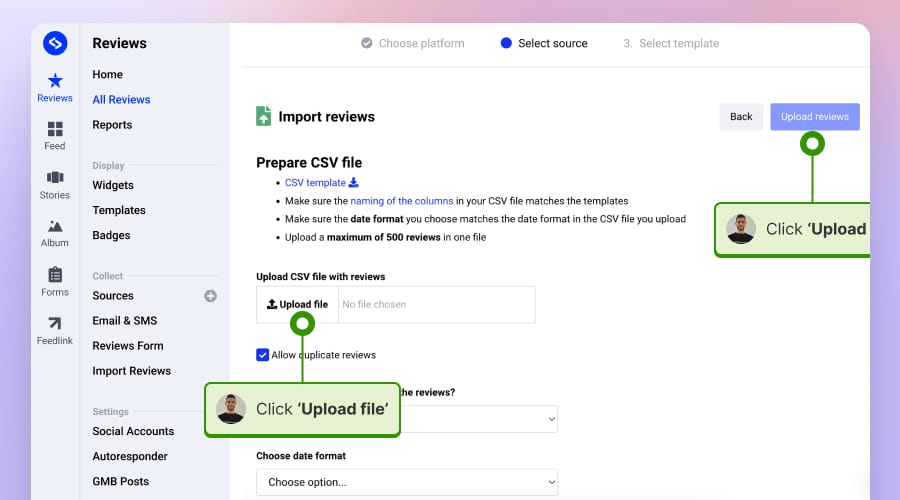
7. Demander des témoignages vidéo
Parfois, recueillir un témoignage vidéo est plus facile et plus efficace qu'on ne le pense, surtout si vous disposez d'un représentant commercial spécialisé qui s'entretient quotidiennement avec vos clients et qui peut leur demander de dire quelques mots sur leur expérience avec vos produits et services.
En rapport :
8. Obtenir des témoignages par le biais de cartes NFC
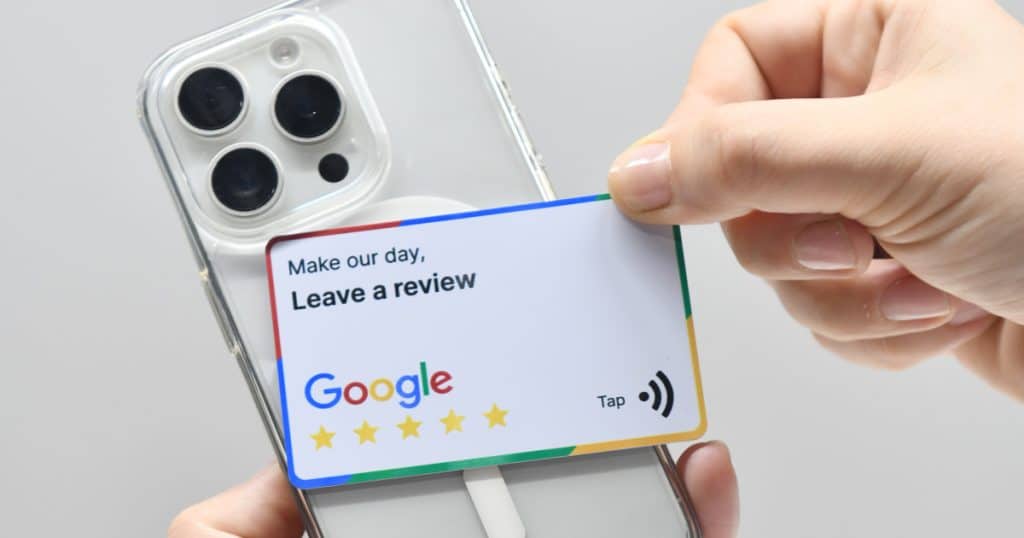
Les cartes numériques NFC sont la dernière tendance en matière de cartes de visite. Il s'agit généralement de cartes en plastique qui, lorsqu'elles sont tapées sur un téléphone équipé de la technologie NFC (Near Field Communication), peuvent renvoyer à une page où les gens peuvent laisser leurs témoignages.
Par exemple, la carte NFC "Google reviews", lorsqu'elle est touchée, redirige le client vers le lien "Google reviews" qui lui permet de rédiger un commentaire directement sur l'emplacement Google de l'entreprise.
Comment demander des témoignages ? + Questions
Nous avons mentionné ci-dessus les méthodes pour demander des témoignages, mais ici, nous allons partager ce qu'il faut réellement dire ou écrire lorsque l'on demande des témoignages. Voici une liste de contrôle qui vous aidera demander un témoignage:
Demandez à échanger des témoignages
Si vous avez collaboré avec d'autres entreprises ou professionnels et que les deux parties sont satisfaites du partenariat, envisagez d'échanger des témoignages élogieux. Il s'agit d'une situation gagnant-gagnant dans laquelle les deux parties bénéficient d'un retour d'information positif.
Exemple: "Nous avons eu une excellente expérience de collaboration. Seriez-vous intéressés par un échange de témoignages pour nos sites web respectifs ?"
Accompagnez votre demande d'un compliment
Lorsque vous demandez un témoignage, commencez par complimenter le client ou exprimez votre gratitude pour son travail. Cela donne un ton positif et rend la demande moins transactionnelle.
Exemple: "Nous avons vraiment apprécié de travailler avec vous et nous sommes fiers des résultats que nous avons obtenus ensemble. Seriez-vous prêt à partager un témoignage sur votre expérience ?"
Soyez sincère et reconnaissant
L'une des façons les plus simples d'obtenir des témoignages de clients est de leur témoigner une véritable reconnaissance pour le temps qu'ils ont consacré à votre projet et pour leurs commentaires. Remerciez-le d'avoir pris en considération votre demande, qu'il choisisse ou non de fournir un témoignage.
Exemple: "Vos commentaires sont très importants pour nous. Que vous choisissiez ou non de fournir un témoignage, nous sommes reconnaissants d'avoir eu l'occasion de vous servir."
Exemples de questions de témoignage pour des réponses de qualité
Vous avez réalisé une vente et aimeriez recevoir un retour d'information, mais vous ne savez pas comment formuler votre demande ? Vous pouvez toujours commencer par utiliser la question modèles de témoignages comme celles-ci :
Basé sur l'expérience Questions sur les témoignages:
- Quelle était votre principale préoccupation concernant l'achat de notre produit/service ?
- Pouvez-vous nous décrire une expérience particulière qui vous a marqué ?
- Comment notre produit/service a-t-il changé votre vie quotidienne ou vos activités professionnelles ?
Questions basées sur les résultats :
- Quels résultats spécifiques avez-vous obtenus depuis que vous utilisez notre produit/service ?
- Pouvez-vous nous faire part d'un résultat mesurable ou d'une statistique démontrant la valeur que vous avez reçue ?
Questions basées sur des recommandations :
- Quelle est la probabilité que vous recommandiez notre produit/service à un collègue ou à un ami ? Pourquoi ?
- Si quelqu'un hésitait à utiliser notre produit/service, que lui diriez-vous ?
Questions sur les témoignages visuels :
- Seriez-vous prêt à partager une photo ou une vidéo de vous en train d'utiliser notre produit/service ?
- Pouvez-vous fournir un visuel avant et après pour montrer l'impact de notre produit/service ?
Pourquoi recueillir des témoignages ?
La collecte de témoignages de clients offre également une myriade d'avantages aux entreprises et aux professionnels :
Ils renforcent la confiance et la crédibilité
Les témoignages servent de preuve sociale que votre produit ou service est fiable et de haute qualité.
Les témoignages positifs de clients réels peuvent contribuer à renforcer la confiance dans les entreprises locales et à établir leur crédibilité auprès des clients potentiels.
Ils renforcent la réputation de la marque
Les témoignages positifs de clients peuvent améliorer la réputation de votre marque.
Lorsque des clients potentiels voient un témoignage positif ou un retour d'information de la part de clients satisfaits, cela influence positivement la perception qu'ils ont de votre marque.
Ils facilitent le processus de prise de décision
Les témoignages fournissent l'assurance nécessaire pour procéder à l'achat.
Les témoignages élogieux aident les acheteurs potentiels en facilitant la prise de décision grâce à des expériences positives vécues par des clients existants.
Ils augmentent les taux de conversion
Les témoignages figurant dans votre matériel de marketing (ou sur votre site web) augmentent les taux de conversion.
Ce sont des outils de persuasion qui convainquent les clients potentiels et actuels de la valeur et de l'efficacité de votre produit ou service, les encourageant à l'acheter ou à s'inscrire à un service.
Ils fournissent un retour d'information précieux
La collecte de témoignages peut également apporter un retour d'information précieux sur vos produits ou services.
Les témoignages positifs de clients peuvent mettre en évidence les points forts de votre offre, tandis que les commentaires constructifs peuvent vous aider à identifier les points à améliorer.
Ils renforcent la stratégie de référencement
Ils peuvent stimuler efficacement votre stratégie de référencement et vos listes de recherche locales.
Le contenu frais et original de votre page de témoignages peut améliorer le classement de votre site web dans les moteurs de recherche, ce qui contribue à augmenter le trafic organique.
Faites plus en affichant vos témoignages
Une fois que vous avez obtenu ces témoignages étonnants, vous devez les afficher sur votre site web ou sur vos pages de médias sociaux. Voici quelques moyens de mettre en valeur tout ce que vous avez recueilli.
Affichez des témoignages sur votre site web
Une fois que vous avez créé la page de témoignages, vous pouvez utiliser votre compte gratuit EmbedReviews et afficher les commentaires sur votre page professionnelle Facebook ou sur n'importe quel site web.
Pour ce faire, suivez les étapes ci-dessous :
- Étape 1 : Allez dans Widgets et cliquez sur Nouveau widget".
- Étape 2 : Choisissez la source de vos commentaires et cliquez sur 'Créer un widget'.
- Étape 3 : Vous serez transféré vers l'éditeur, où vous pourrez entièrement personnaliser le widget de témoignages.
- Étape 4 : Collez le code dans la section HTML du corps de votre site web.
C'est tout.
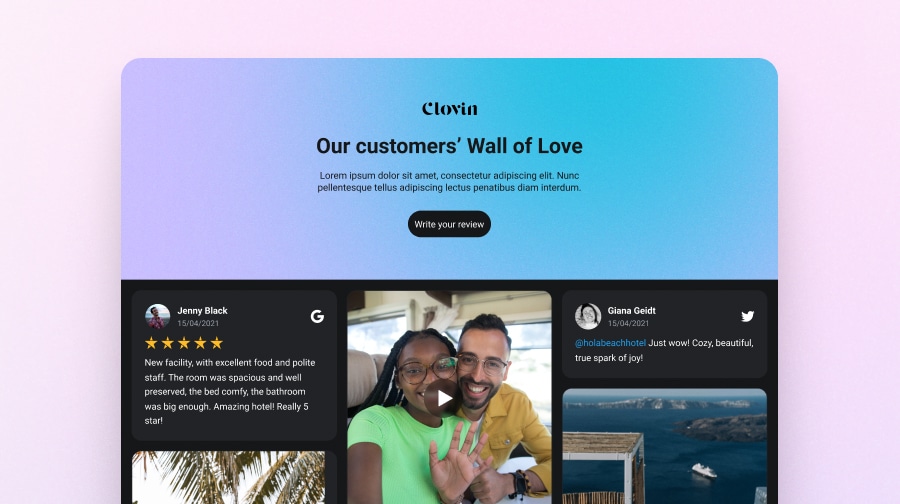
En quelques clics, vous créerez une page de témoignages efficace avec tous vos témoignages en un seul endroit. Voici un exemple vidéo complète de la façon dont vous pouvez utiliser le widget Forever Free Reviews pour collecter des avis de clients sur votre site web et afficher ces avis sur des pages de destination de votre site web :
Vous voulez savoir comment des marques populaires intègrent des témoignages sur leur site web ? Jetez un coup d'œil à ces sites :
Transformer les témoignages de clients en publicités Facebook
L'une des meilleures façons d'utiliser les témoignages que vous recueillez est de les ajouter à vos nouvelles publicités. Vous les présenterez ainsi au plus grand nombre possible de clients potentiels.
EmbedReviews offre une fonction fantastique qui permet aux utilisateurs d'utiliser leurs commentaires pré-générés et de créer une publicité Facebook en quelques clics sur une seule page.
Veuillez noter que les paiements sont traités par le biais de vos comptes publicitaires Facebook, ce qui signifie que notre système ne prend aucune commission pour les publicités que vous créez.
En rapport :
Présenter des témoignages de clients hors ligne
Saviez-vous que vous pouvez utiliser les commentaires de vos clients comme preuve sociale en dehors d'Internet ?
Ce n'est pas si difficile à faire, car il existe de nombreuses façons d'exposer les éloges que vous recevez. Voici quelques-uns des moyens les plus créatifs et les plus efficaces d'exploiter les témoignages de clients dans le domaine hors ligne :
- Matériel imprimé :
- Brochures et dépliants : Incorporez des témoignages dans les brochures, les dépliants et autres documents marketing imprimés distribués lors d'événements, dans les magasins ou par courrier.
- Cartes de visite : Faites figurer un témoignage court et percutant au dos de vos cartes de visite. Vous pouvez également utiliser une version numérique, comme Carte de visite d'UniqodeLe site web de la Commission européenne peut également inclure un code QR scannable qui renvoie directement à une page complète de témoignages ou à un formulaire d'évaluation.
- Présentations en magasin :
- Affiches et bannières : Concevez des affiches et des bannières accrocheuses présentant des témoignages de clients et placez-les à des endroits stratégiques de votre magasin ou de votre bureau.
- Emballage du produit : Imprimez des témoignages sur l'emballage des produits pour instaurer la confiance et influencer les décisions d'achat.
- Événements et salons :
- Conception du stand : Intégrez des témoignages dans la conception de votre stand lors de salons et d'expositions.
- Présentations : Mettez en avant les commentaires des clients lors de vos présentations et discours pour renforcer votre crédibilité.
- Campagnes de publipostage :
- Cartes postales et lettres : Envoyez des publipostages personnalisés contenant des témoignages à des clients cibles ou à des prospects.
- Bulletins d'information : Incluez une section consacrée aux commentaires des clients dans les bulletins d'information imprimés de votre entreprise.
- Point de vente :
- Reçus et factures : Imprimez de courts témoignages au bas des reçus ou des factures.
- Caisse de paiement : Affichez des témoignages près de la caisse pour renforcer les expériences positives.
- Défense des intérêts des employés :
- Formation : Sensibiliser les employés aux témoignages clés afin qu'ils puissent les partager lors des interactions avec les clients.
- Livret de témoignages : Créez un livret de témoignages que les représentants commerciaux pourront partager avec des clients potentiels.
- Communiqués de presse et médias :
- Dossiers de presse : Inclure des témoignages dans les dossiers de presse envoyés aux médias.
- Entretiens avec les médias : Mentionnez les témoignages de vos clients lors d'interviews dans les journaux, les magazines, à la radio ou à la télévision.
- Sensibilisation de la communauté :
- Parrainages locaux : Faire figurer des témoignages dans les documents relatifs aux parrainages locaux ou aux événements communautaires.
- Conseils communautaires : Affichez les témoignages sur les tableaux d'affichage des centres locaux, des bibliothèques ou des écoles.
Comme vous pouvez le constater, il est facile d'intégrer le retour d'information des clients dans les canaux hors ligne et de compléter votre stratégie de marketing en ligne à un coût insignifiant.
Comment analyser les témoignages des clients ?
L'analyse des témoignages de clients permet d'acquérir des connaissances, d'identifier des tendances et d'améliorer vos produits, vos services et l'expérience de vos clients. En général, vous devrez suivre l'une ou l'autre de ces étapes, voire toutes, pour analyser en profondeur les avis que vous recevez de vos clients :
- Classer le retour d'information par catégorie :
- Classez les témoignages par catégories en fonction des thèmes, des produits, des services ou des caractéristiques mentionnés.
- Identifier les éloges ou les préoccupations les plus courantes des clients.
- Analyse des sentiments :
- Utilisez des outils d'analyse des sentiments pour déterminer le ton général des témoignages (positif, négatif, neutre).
- Identifier des mots ou des phrases spécifiques qui sont fréquemment associés à des sentiments positifs ou négatifs.
- Identifier les tendances et les modèles :
- Recherchez des thèmes ou des schémas récurrents dans le retour d'information.
- Analyser la fréquence des éloges ou des préoccupations spécifiques afin d'identifier les points forts et les points à améliorer.
- Mesurer l'impact :
- Évaluer l'impact des témoignages sur les indicateurs clés de performance (ICP) tels que les taux de conversion, la fidélisation de la clientèle et la réputation de la marque.
- Suivre l'évolution du comportement ou de l'engagement des clients suite à la publication de témoignages.
- Segmentation de la clientèle :
- Segmentez les témoignages en fonction des données démographiques du client, de son historique d'achat ou de son comportement.
- Analyser les réactions de différents segments de clientèle pour adapter les produits, les services ou les stratégies de marketing.
- Comparaison des concurrents :
- Comparez vos témoignages à ceux de vos concurrents afin d'identifier les arguments de vente uniques (USP) ou les domaines dans lesquels les concurrents peuvent avoir un avantage.
- Ajuster les stratégies en fonction des informations sur la concurrence.
- Des informations exploitables :
- Traduire l'analyse en idées exploitables pour améliorer les produits, les services, l'expérience des clients ou les stratégies de marketing.
- Prioriser les domaines d'amélioration en fonction de l'importance et de la fréquence du retour d'information.
- Contrôler les progrès :
- Suivre en permanence les nouveaux témoignages et les retours d'information afin d'évaluer les progrès accomplis et d'identifier les nouvelles tendances ou les nouveaux problèmes.
- Ajuster les stratégies et les actions sur la base d'une analyse continue.
L'analyse systématique des avis clients permet aux entreprises d'obtenir des informations précieuses, d'améliorer la satisfaction des clients et de prendre des décisions éclairées pour favoriser la croissance et la réussite.
Exemples de témoignages sur un site web
La possibilité d'afficher et de recevoir des témoignages sur votre site web est facilitée par l'utilisation de widgets de témoignages. Vous trouverez ci-dessous quelques exemples de widgets que vous pouvez parcourir et choisir pour commencer.
Conclusion
Il est essentiel de comprendre comment recueillir, utiliser et analyser les témoignages pour renforcer la réputation d'une entreprise et favoriser sa croissance. Lorsque vous recevez des éloges, vous devez les afficher dès que possible, ce que vous pouvez et devez faire à la fois en ligne et hors ligne.
Qu'il s'agisse d'amplifier la voix de votre marque sur les médias sociaux, d'améliorer votre stratégie de référencement ou de transformer les commentaires positifs en publicités convaincantes, vous devez vous rappeler que la voix authentique de vos clients satisfaits et fidèles est votre outil de marketing le plus puissant.
